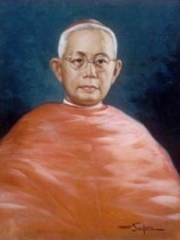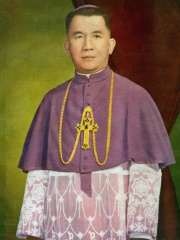
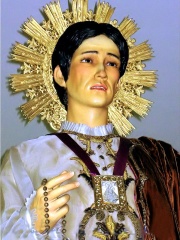

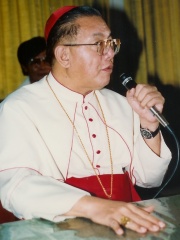
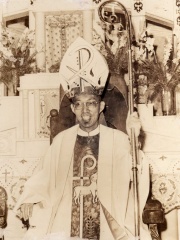
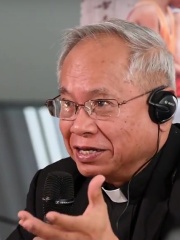

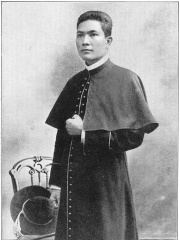
The Most Famous
RELIGIOUS FIGURES from Philippines
This page contains a list of the greatest Filipino Religious Figures. The pantheon dataset contains 3,187 Religious Figures, 13 of which were born in Philippines. This makes Philippines the birth place of the 36th most number of Religious Figures behind Canada, and Slovakia.
Top 10
The following people are considered by Pantheon to be the top 10 most legendary Filipino Religious Figures of all time. This list of famous Filipino Religious Figures is sorted by HPI (Historical Popularity Index), a metric that aggregates information on a biography's online popularity. Visit the rankings page to view the entire list of Filipino Religious Figures.

1. Luis Antonio Tagle (b. 1957)
With an HPI of 74.40, Luis Antonio Tagle is the most famous Filipino Religious Figure. His biography has been translated into 43 different languages on wikipedia.
Luis Antonio Gokim Tagle ( TAH-gleh, Tagalog: [lʊˈwis ɐnˈtonɪo ˈtaɡlɛ]; born June 21, 1957) is a Filipino prelate of the Catholic Church, and has been the Pro-Prefect for the Section for First Evangelization and New Particular Churches of the Dicastery for Evangelization (formerly Congregation for the Evangelization of Peoples) since December 8, 2019. He previously served as the 32nd Archbishop of Manila from 2011 to 2020, and earlier on as Bishop of Imus from 2001-2011. Tagle is the current Cardinal Bishop of Albano and also serves as the President of the Catholic Biblical Federation, Grand Chancellor of the Pontifical Urbaniana University, President of Interdicasterial Commission for Consecrated Religious, and as a member of various departments and dicasteries in the Roman Curia. He is often referred to by his nickname, Chito. Dubbed the "Asian Francis", Tagle is often seen as a representative of the Catholic Church's progressive wing. He was called a papabile for the papal conclaves of 2013 and 2025.

2. Lorenzo Ruiz (1600 - 1637)
With an HPI of 68.89, Lorenzo Ruiz is the 2nd most famous Filipino Religious Figure. His biography has been translated into 23 different languages.
Lorenzo Ruiz (Filipino: Lorenzo Ruiz ng Maynila; Chinese: 李乐伦; pinyin: Lǐ Yuèlún; Spanish: Lorenzo Ruiz de Manila; November 28, 1594 – September 29, 1637), also called Saint Lorenzo of Manila, was a Filipino Catholic layman and a member of the Third Order of Saint Dominic. A Chinese Filipino, he became his country's protomartyr after his execution in Japan by the Tokugawa shogunate during its persecution of Japanese Christians in the 17th century. Lorenzo Ruiz is the patron saint of, among others, the Philippines and the Filipino people.

3. Oscar Cruz (1934 - 2020)
With an HPI of 57.87, Oscar Cruz is the 3rd most famous Filipino Religious Figure. His biography has been translated into 17 different languages.
Oscar Valero Cruz (November 17, 1934 – August 26, 2020) was a Filipino prelate of the Catholic Church in the Philippines. He was the Archbishop of Lingayen–Dagupan in Pangasinan, Philippines, from 1991 until his retirement in 2009.

4. Jaime Sin (1928 - 2005)
With an HPI of 57.77, Jaime Sin is the 4th most famous Filipino Religious Figure. His biography has been translated into 28 different languages.
Jaime Lachica Cardinal Sin, (Chinese: 辛海梅, 辛海棉; Pe̍h-ōe-jī: Sin Hái-mûi, Sin Hái-mî; August 31, 1928 – June 21, 2005), commonly and also formally known as Cardinal Sin, was the 30th Catholic Archbishop of Manila and the third cardinal from the Philippines. He was instrumental in the historic and peaceful 1986 People Power Revolution, which toppled the dictatorship and ended martial law under Ferdinand Marcos and installed Corazon Aquino as his successor in the Fifth Republic of the Philippines. He was also a key figure in the 2001 EDSA Revolution that replaced President Joseph Estrada with Gloria Macapagal Arroyo.
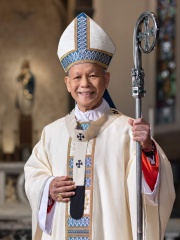
5. Jose Advincula (b. 1952)
With an HPI of 56.61, Jose Advincula is the 5th most famous Filipino Religious Figure. His biography has been translated into 21 different languages.
José Lázaro Fuerte Advíncula Jr. (born March 30, 1952) is a Filipino friar of the Dominican Order and a prelate of the Catholic Church who has been the 33rd and present Metropolitan Archbishop of Manila since 2021. He previously served as Bishop of San Carlos from 2001 to 2011, and Metropolitan Archbishop of Cápiz from 2011 to 2021. On December 16, 2020, Pope Francis appointed Advíncula as a member of the Dicastery for Clergy, and made him a cardinal in November 2020.

6. Gaudencio Rosales (b. 1932)
With an HPI of 54.53, Gaudencio Rosales is the 6th most famous Filipino Religious Figure. His biography has been translated into 24 different languages.
Gaudencio Borbón Rosales (born August 10, 1932), also known as Lolo Dency, is a Filipino Catholic prelate who served as Archbishop of Manila, from 2003 to 2011. He was made a cardinal in 2006. Rosales was the fourth native Filipino to hold the post. During his last year as archbishop, he was concurrently named apostolic administrator of the Diocese of Pasig from December 21, 2010 to June 23, 2011, a post he accepted after the resignation of Pasig's first bishop, Francisco San Diego. He is also the longest-lived Filipino cardinal, surpassing Cardinal Jose Tomas Sanchez.

7. Orlando Quevedo (b. 1939)
With an HPI of 53.20, Orlando Quevedo is the 7th most famous Filipino Religious Figure. His biography has been translated into 25 different languages.
Orlando Beltran Quevedo (Spanish pronunciation: [keˈβeðo]; born March 11, 1939) is a Filipino prelate of the Catholic Church. A cardinal since 2014, he was Archbishop of Cotabato from 1998 to 2018. He became a bishop in 1980.

8. Wenceslao Padilla (1949 - 2018)
With an HPI of 52.74, Wenceslao Padilla is the 8th most famous Filipino Religious Figure. His biography has been translated into 17 different languages.
Wenceslao Selga Padilla (29 September 1949 – 25 September 2018) was a Filipino Scheut priest who from 2 August 2003 was the Apostolic prefect of the Apostolic Prefecture of Ulaanbaatar, a pre-diocesan missionary jurisdiction of the Roman Catholic Church in Mongolia.

9. Gregorio Aglipay (1860 - 1940)
With an HPI of 51.15, Gregorio Aglipay is the 9th most famous Filipino Religious Figure. His biography has been translated into 18 different languages.
Gregorio Aglipay Cruz y Labayán (Latin: Gregorius Aglipay Cruz; Filipino: Gregorio Labayan Aglipay Cruz; pronounced uhg-LEE-pahy; May 5, 1860 – September 1, 1940) was a Filipino former Roman Catholic priest and revolutionary during the Philippine Revolution and Philippine–American War who became the first head and leader of the Iglesia Filipina Independiente (IFI), the first-ever wholly Filipino-led independent Christian Church in the Philippines in the form of a nationalist church. Known for inciting patriotic rebellion among the Filipino clergy during the Philippine Revolution and Philippine–American War, he was also a political activist who became acquainted with writer and labor leader Isabelo de los Reyes who would then start an independent Christian Filipino Church colloquially named after Aglipay in 1902 as a revolt against the Roman Catholic Church, which was the state religion of the Philippines at the time, due to the mistreatment of the Spanish friars towards the Filipinos. Contrary to popular belief, Aglipay did not join the IFI until one month from its proclamation by de los Reyes and the Unión Obrera Democrática. Aglipay was previously excommunicated by Archbishop Bernardino Nozaleda y Villa of Manila in May 1899, upon the expressed permission of Pope Leo XIII, due to his involvement in revolutionary activities, despite his prior intercession and defense of some of the Spanish Roman Catholic clergy from liberal-nationalist Filipino revolutionaries. The Roman Catholic Church made attempts to bring Aglipay back to their fold, but failed. Aglipay joined Freemasonry in May 1918, a society excommunicated by the Roman Catholic Church. Aglipay married Pilar Jamias y Ver from Sarrat, Ilocos Norte in 1939 and then died one year later. Followers of Aglipay through the Church are sometimes colloquially referred to by their membership as Aglipayans.
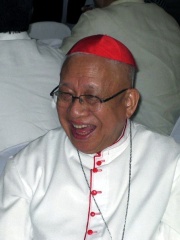
10. Ricardo Vidal (1931 - 2017)
With an HPI of 50.85, Ricardo Vidal is the 10th most famous Filipino Religious Figure. His biography has been translated into 26 different languages.
Ricardo Tito Jamin Vidal (February 6, 1931 – October 18, 2017) was a Filipino prelate of the Catholic Church in the Philippines. Made a cardinal in 1985, he was Archbishop of Cebu from 1982 to 2010.
People
Pantheon has 13 people classified as Filipino religious figures born between 1600 and 1957. Of these 13, 4 (30.77%) of them are still alive today. The most famous living Filipino religious figures include Luis Antonio Tagle, Jose Advincula, and Gaudencio Rosales. The most famous deceased Filipino religious figures include Lorenzo Ruiz, Oscar Cruz, and Jaime Sin.
Living Filipino Religious Figures
Go to all RankingsLuis Antonio Tagle
1957 - Present
HPI: 74.40
Jose Advincula
1952 - Present
HPI: 56.61
Gaudencio Rosales
1932 - Present
HPI: 54.53
Orlando Quevedo
1939 - Present
HPI: 53.20
Deceased Filipino Religious Figures
Go to all RankingsLorenzo Ruiz
1600 - 1637
HPI: 68.89
Oscar Cruz
1934 - 2020
HPI: 57.87
Jaime Sin
1928 - 2005
HPI: 57.77
Wenceslao Padilla
1949 - 2018
HPI: 52.74
Gregorio Aglipay
1860 - 1940
HPI: 51.15
Ricardo Vidal
1931 - 2017
HPI: 50.85
Jose Tomas Sanchez
1920 - 2012
HPI: 49.37
Rufino Santos
1908 - 1973
HPI: 48.76
Julio Rosales
1906 - 1983
HPI: 47.45
Overlapping Lives
Which Religious Figures were alive at the same time? This visualization shows the lifespans of the 8 most globally memorable Religious Figures since 1700.


